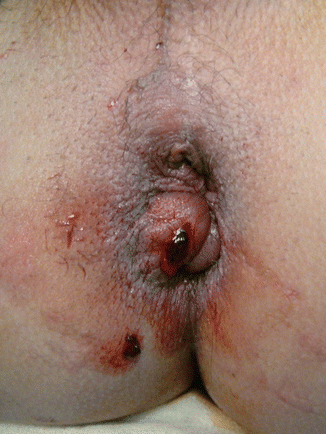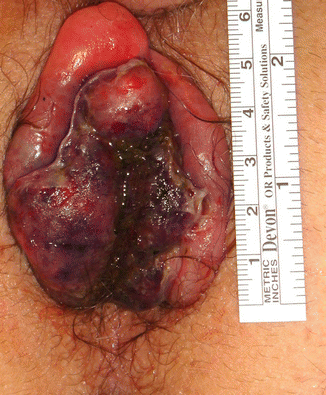Fig. 8.1
A chronic anal fissure
8.4 Acute Hemorrhoidal Disease
Hemorrhoids are not masses of dilated venules. The anal cushions are composed of blood vessels, smooth muscle (Treitz’s muscle), and elastic connective tissue in the submucosa. Three cushions lie in left lateral, right anterolateral, and right posterolateral positions. The prolapse of these anal cushions is defined as hemorrhoids. In the presence of irreducible prolapse or thrombosis of hemorrhoids, generally present with severe edema and severe pain as main symptoms where surgery may be required.
8.5 Grading of Hemorrhoids
Degree | Description |
|---|---|
I | Hemorrhoids prolapse beyond the dentate line on straining |
II | Hemorrhoids prolapse through the anus on straining but reduce spontaneously |
III | Hemorrhoids prolapse through the anus which require manual reduction |
IV | Prolapsed hemorrhoids cannot be manually reduced |
Prolapsed third-degree or fourth-degree hemorrhoids may cause strangulation. On examination, edema is obvious, and if untreated, prolapsed hemorrhoids may end up with ulceration and necrosis. Thrombosed or strangulated hemorrhoids due to hormonal changes and the pressure of the fetus on pelvic veins can cause a serious problem in pregnant and postpartum women.
8.6 Thrombosed External Hemorrhoids
Thrombosis of external hemorrhoids (Fig. 8.2) occurs with an unknown cause, and follows an abrupt onset of anal mass and pain within 48 h. The pain diminishes after the fourth day and if left alone dissolves spontaneously in a few weeks. The treatment should consist of pain relief, prevention of recurrent thromboses, and residual skin tags. The thrombus is excised with local or general anesthesia. Greenspon et al. detected on a case series of 231 patients with thrombosed hemorrhoids that with conservative treatment, symptoms resolved in 24 days and with surgery in 4 days. The recurrence rate was 25 % in the conservative group and 6 % in the surgery group.


Fig. 8.2
A thrombosed external hemorrhoid
8.7 Strangulated Hemorrhoids
Strangulated hemorrhoids (Fig. 8.3) arise from prolapsed Grade 3 or 4 hemorrhoids that cannot be reduced due to excessive swelling. The edema may progress to ulceration or necrosis if not treated with urgent three quadrant hemorrhoidectomy. If the procedure is performed with stapled hemorrhoidopexy without decompressing the edematous tissue, pain is more compared to the hemorrhoidectomy technique in the immediate postoperative period, but less in 6 weeks.


Fig. 8.3
A strangulated hemorrhoid
8.8 Hemorrhoids in Pregnancy
Acute prolapse and thrombosis during pregnancy require hemorrhoidectomy and should be treated under local anesthesia. Immediate postpartum period is the best term for hemorrhoidectomy. Mild laxatives are proven to be helpful in the last 3 months of pregnancy. Traumatic deliveries, such as perineal tear and heavy babies, were associated with thrombosed external hemorrhoids.
8.9 Hemorrhoids and Portal Hypertension
Hemorrhoid are quite common (almost 60 %) in portal hypertension. Patients with large esophageal varices have more frequent anorectal varices. Anorectal varices rarely bleed compared to esophageal varices. Bleeding hemorrhoids in patients with portal hypertension must be distinguished from anorectal varices, true consequence of portal hypertension. Bleeding from anorectal varices can be controlled with absorbable running sutures.
8.10 Hemorrhoids in Inflammatory Bowel Disease
The treatment of hemorrhoids is accepted as safe in patients with ulcerative colitis, whereas it is relatively contraindicated in patients with Crohn’s disease and only recommended in a quiescent stage.
8.11 Hemorrhoids in Leukemia
Surgical treatment of patients with leukemia or lymphoma presenting with hemorrhoidal disease is quite difficult, since abscesses are common and wound healing is rather poor. Surgery does not increase the mortality in these high-risk patients, but is performed to relieve pain and sepsis usually caused by Escherichia coli and Pseudomonas aeruginosa.
8.12 Proctitis
Proctitis is an inflammation limited to the rectum. Inflammation leads to bleeding and mucous secretion. Although constipation may be encountered, diarrhea is more frequent. Irritation of the rectum may cause an urgency to defecate. There is a tendency to spread proximally during the course, which is defined as proctocolitis.
8.13 Acute Cryptoglandular Infection
The majority of anorectal suppurative disease results from obstruction and infection of the ducts of mucous-secreting anal glands (cryptoglandular infection) found in the intersphincteric plane. Their ducts traverse the internal sphincter and empty into the anal crypts at the level of the dentate line. Infection of an anal gland results in the formation of an abscess that enlarges and spreads along one of several planes in the perianal and perirectal spaces, which are unable to resist the spread of infection and lead to various clinical presentations at the perineum.
Stay updated, free articles. Join our Telegram channel

Full access? Get Clinical Tree







